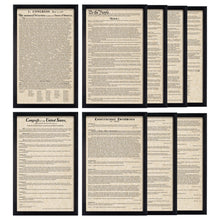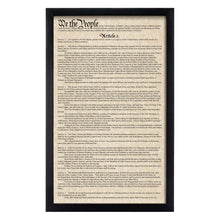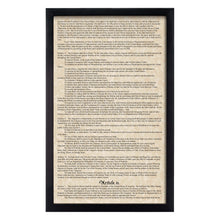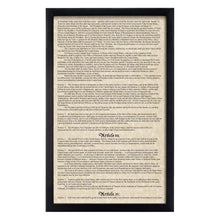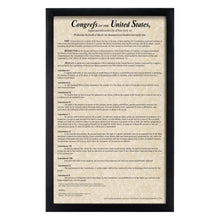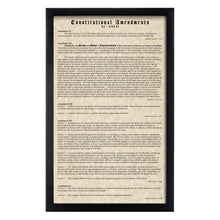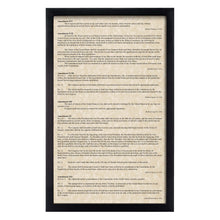
This customized nine-frame set contains the Declaration of Independence, U.S. Constitution and all 27 constitutional amendments including the Bill of Rights. Some would suggest these historical documents, taken collectively, represent our nation's fundamental "canon" of political writ or philosophy of government, with all our many laws—federal, state and local—but an outgrowth of them.
Further, the Constitution, Bill of Rights and all other constitutional amendments, collectively, really represent our entire "Constitution," or "law of the land," since the latter serve to amend or modify—or in some cases supplant portions of—the former.
The set is designed to hang on the wall and comes with –
- parchment paper
- wood frames (9 ¼" x 14 ¾" each)
- glass panes
The Declaration of Independence, Constitution and Bill of Rights have been carefully stylized to reflect the look of the originals while containing the same words, spelling (and occasional misspellings), punctuation, capitalization, etc. They've just been reformatted into a modern font (versus old-style calligraphy) to make them easier to read. They have the identical signers in the same columns or positions as the originals—they're just italicized names instead of signatures to easily identify who signed them.
All the calligraphic elements were retained in the Declaration of Independence, such as in the heading and certain words or phrases, e.g., "united States of America" and "Free and Independent States," as well as in the Constitution, such as in the preamble and closing endorsement, where more ornate lettering was used in the original documents and made to look darker. Even the last line of each page of the Constitution was deliberately formatted to correspond to the last line on the original parchment pages.
Of note, the original Bill of Rights document never actually contained the words "Bill of Rights." It simply outlined 12 "proposed" amendments to the Constitution as "Article the first.....," "Article the second.....," "Article the third.....," etc., for the states to consider ratifying. But the first (revising the math on the number of members in the House of Representatives) was never ratified and the second not till 1992 when it became the 27th Amendment. So "Article the third....." was relabeled "Amendment I," "Article the fourth.....," "Amendment II" and so on to precisely correspond to the first ten constitutional amendments representing our present-day Bill of Rights. This was the only modification to the text of the document.
The final three frames contain the complete language of all 17 constitutional amendments that followed the Bill of Rights, compiled from 17 different documents written over the course of nearly 200 years. The words, punctuation, capitalization, etc., are exactly the same, and the formatting reflects the style conventions used in each of the amendment documents.
Declaration of Independence
Written in 1776, the Declaration of Independence has been referred to as the "soul of our country." Without the Declaration of Independence, there is no United States, there is no Constitution. While Thomas Paine greatly influenced public support for independence, the declaration itself was written by Thomas Jefferson, with input from John Adams, Benjamin Franklin and other Continental Congress patriots. It details in fair-minded, inspired prose the long history of abuses and injustices suffered by the American colonies under Great Britain's King George III and why, reluctantly, they could no longer be subject to the British Crown. At the peril of committing treason, 56 courageous men then signed the document.
Decades later, Abraham Lincoln advocated strongly that the principles outlined in the Declaration of Independence should serve as the moral compass by which the Constitution is interpreted.
Constitution
The Americans won the Revolutionary War, and a promising nation was born. But George Washington soon observed the states seemed bound together by a "rope of sand," and others like Alexander Hamilton agreed. For the battle not to have been in vain, for the new republic's "great experiment" in free self-governance to last, a stronger frame of government was needed. To that end, a group of men gathered for a "Constitutional Convention" in 1787 presided over by Washington and comprised arguably of some of the wisest, most intelligent, educated and experienced statesmen ever assembled. Though imperfect, they shared a common vision and resolve to "form a more perfect union" and understood clearly the magnitude of what needed to be done. James Madison drafted the general framework, and through a series of animated debates, revisions and compromises, a workable document emerged, some say miraculously, in just four months that is our present-day Constitution.
Bill of Rights
In the Constitutional Convention's push to strengthen the federal government to preserve the union, some felt the pendulum swung too far by not explicitly safeguarding individual and state rights. Acutely mindful of the recent struggle to "throw off" tyrannical government, many states would not ratify the Constitution without the assurance of a Bill of Rights. In response, James Madison set out to correct this oversight by drafting one which included provisions for the freedom of religion and speech, the right to bear arms, the right to due process and a speedy trial before an impartial jury and so forth. Approved by the very first United States Congress and submitted to the states as promised, ten constitutional amendments became ratified in 1791 commonly known today as the Bill of Rights.
Constitutional Amendments 11-27
With prudent foresight, the Founding Fathers had written Article V into the Constitution so it could be amended as necessary, as clearly evidenced by the Bill of Rights. Accordingly, amendments didn't stop after those first ten. But the bar for amending it was purposely set high so it wouldn't be changed whimsically but only after careful deliberation on matters considered truly important. Once ratified, amendments literally become part of our Constitution, often, like the 12th and 17th Amendments, replacing language in the document.
Over the years, additional constitutional amendments have included the abolition of slavery, the right to vote regardless of race, the establishment of a federal income tax, Prohibition (and later the repeal of Prohibition), women's suffrage, presidential term limits, representation in the Electoral College for the District of Columbia, and the procedure for removing a president when unable to perform the duties of his office, sometimes called simply the 25th Amendment.











